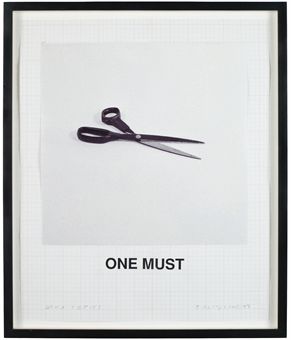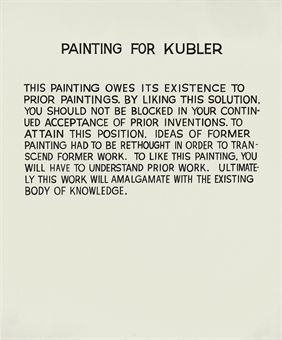Enlarge: www.3quarksdaily.com/.a/6a00d8341c562c53ef0120a69f0df3970b-800wi
God Nose by JB
From www.3quarksdaily.com/3quarksdaily/2009/11/words-images-and-playing-games.html:
'Baldessari’s work is full of paradox. It liberates, irritates, inspires and disarms and has been an enormous influence on a whole generation of younger artists. Like looking through a kaleidoscope, he presents us with what is familiar with an unfamiliar twist so that we are forced to think about things in a slightly different way. We are continually confronted by images that ask ‘is this art?’ and if so does such a definition matter as long as the work prods us and makes us look at the world afresh. Baldessari’s own disarming answer, given in an early painting that escaped the Cremation Project, is God Nose.'


From: www.eai.org/eai/artistBio.htm?id=356
A major figure in contemporary art, John Baldessari has been termed "one of the most influential artists to emerge since the mid-1960s." From his phototext canvases of the 1960s to his composite photo collages and installations of the 1980s, Baldessari has contributed to the definition of postmodern art. His ingenious application of certain art-making strategies — including appropriation, deconstruction, decontextualization, sequentiality and text/image juxtaposition — was prescient, as was his cogent and witty integration of semiology, linguistic systems and mass media.
As one of the seminal figures in the language-based Conceptual Art movement of the early 1970s, Baldessari produced a series of videotapes in which he conducted ironic investigations into perception, meaning and interpretation. Rendered with deadpan, often absurdist humor, these droll conceptual exercises make use of cultural artifacts, from film stills and magazine photos to art historical in-jokes, as frameworks for irreverent philosophical inquiries into art and knowledge. With a cunning reliance on misrecognition and misinformation, Baldessari uses irony and incongruity to exploit the gap between what is heard, what is seen, and what is understood. His wry investigations of representation and sign systems succeed through strategies such as the ironic juxtaposition of photographic or video images and written or verbal texts; the use of appropriated material and found objects to underscore the embedded meaning of pop cultural genres; the construction of disjunctive narratives and surreal conjunctions from re-contextualized words and images, and the indexing of objects of actions.
Many of his exercises take the form of parables, allegories, or "art lessons," as Baldessari the performer assumes the role of teacher or storyteller. His fascination with jokes, dreams, aphorisms, sight gags and linguistic pranks, which are linked to Freudian notions of unconscious associations and verbal and written "slips," evoke the visual puns and word games of Dada and Surrealism. Pervaded with reference to art-making and art history, and responding to the tenets of minimalism, performance and Conceptual Art, his tapes question the very limits of art, and form an irreverent critique of modernist practices. Baldessari playfully compels the viewer to question not only the system under investigation — language, representation, narrative, art-making — but also the tools by which the interrogation is being conducted (photography, video, cinema) as conveyers of truth. Ultimately, Baldessari's idiosyncratic, often absurdist logic questions the very process of perception, from vision and meaning to cognition and knowledge.
Baldessari was born in 1931 in National City, California. He received a B.A. and an M.A. from San Diego State College. The recipient of a Guggenheim Fellowship and grants from the National Endowment for the Arts, he has taught at Southwestern University, California; the University of California at San Diego; and the California Institute of the Arts, Valencia.
His work has been exhibited internationally in one person shows at the Stedelijk Museum, Amsterdam; Sonnabend Gallery, New York; Museum Folkwang, Essen, Germany; Contemporary Arts Museum, Houston; Santa Barbara Museum of Art, California; and Centro de Arte Reina Sofia, Madrid, among other institutions; and in group shows at the Contemporary Arts Museum, Houston; Documentas 4,5 and 6, Kassel, Germany; Venice Bienale; Palais des Beaux Arts, Brussels; Everson Museum of Art, Syracuse; The Museum of Modern Art, New York; Kolnischer Kunstverein, Cologne; and the Whitney Museum of American Art Biennial, New York, among others.
In 1990, he was the subject of a major retrospective at the Museum of Contemporary Art, Los Angeles, which traveled to numerous sites around the country. In conjunction with this exhibition, a comprehensive catalogue of his work, entitled John Baldessari, was published in 1990.
In 2009, his retrospective exhibition Pure Beauty opened at the Tate Modern in London. It will travel to the Museu d'Art Contemporani de Barcelona, the Los Angles County Museum of Art, and the Metropolitan Museum of Art, New York, in 2010 and 2011. The retrospective includes a catalogue publication, also entitled Pure Beauty.



Voluble Luminist Painting for Max Kozloff, 1968
Acrylic on canvas, 59 x 59 inches
From 1966 to 1968 John Baldessari created a series of text-based paintings, hand-lettered by professional sign painters. The use of canvas was his only bow to conventional notions of painting. The canvases contain written extracts from art manuals, his own notebooks, and the essays of contemporary critics, including art writer Max Kozloff. In Voluble Luminist Painting for Max Kozloff, portions of a 1968 Artforum article written by Kozloff have been taken out of context and isolated by the artist. With wit and irony, Baldessari reversed the typical artist-critic relationship, using the tools of the art critic to make the painting.


Kosuth

JB
No comments:
Post a Comment